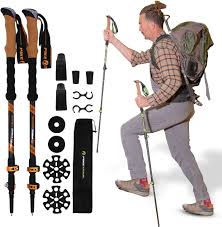The Benefits of Walking Poles: Enhancing Your Walking Experience
Walking poles, also known as trekking poles or hiking poles, are a popular accessory for outdoor enthusiasts and fitness enthusiasts alike. While they may seem simple at first glance, walking poles offer a wide range of benefits that can enhance your walking experience in various ways.
Improved Stability and Balance
One of the primary benefits of using walking poles is the improved stability and balance they provide. By using walking poles, you can distribute your weight more evenly and reduce the strain on your lower body, especially when walking on uneven terrain or steep slopes. This added stability can help prevent falls and injuries, making your walking experience safer and more enjoyable.
Reduced Strain on Joints
Walking poles can also help reduce strain on your joints, particularly in the knees and hips. By using walking poles to support part of your body weight, you can decrease the impact on your joints with each step. This can be especially beneficial for individuals with joint pain or arthritis, allowing them to walk longer distances with less discomfort.
Increased Upper Body Workout
Incorporating walking poles into your walking routine can also provide an additional workout for your upper body muscles. As you use the poles to propel yourself forward, you engage muscles in your arms, shoulders, and core, effectively turning a simple walk into a full-body workout. This added resistance can help improve strength and endurance in your upper body over time.
Enhanced Endurance and Speed
Using walking poles can help increase your endurance and speed while walking. By utilizing your upper body muscles in conjunction with your lower body, you can maintain a more consistent pace for longer periods without feeling fatigued. This can be particularly useful during long hikes or challenging terrain where maintaining momentum is key.
Versatile Usage
Walking poles are versatile tools that can be used in various outdoor activities beyond just hiking or trekking. They are commonly used for Nordic walking, snowshoeing, backpacking, and even urban walking. Whether you’re exploring nature trails or navigating city streets, walking poles offer added support and stability wherever you go.
Conclusion
In conclusion, walking poles are valuable accessories that offer a multitude of benefits for walkers of all levels. From improved stability and reduced joint strain to enhanced upper body workout and increased endurance, walking poles can elevate your walking experience in numerous ways. Consider incorporating walking poles into your routine to enjoy these benefits and make the most of every step you take.
Top 4 Frequently Asked Questions About Walking Poles
- What is the difference between walking poles and trekking poles?
- Do you need 1 or 2 walking poles?
- Are walking poles a good idea?
- Should seniors use walking poles?
What is the difference between walking poles and trekking poles?
Walking poles and trekking poles are terminologies often used interchangeably, but there are subtle differences between the two. While both types of poles serve the same basic purpose of providing stability and support during walking or hiking activities, trekking poles are typically designed with more advanced features for rugged terrain and longer hikes. Trekking poles may have additional features such as adjustable length, shock absorption systems, and sturdy tips for better traction on uneven surfaces. On the other hand, walking poles are generally simpler in design and may be more suited for casual walkers or urban environments where the terrain is less demanding. Ultimately, the choice between walking poles and trekking poles depends on your specific needs and the type of walking or hiking you plan to do.
Do you need 1 or 2 walking poles?
When it comes to walking poles, the number you need largely depends on your personal preference and intended use. While some walkers prefer using a single walking pole for added stability and balance, others opt for a pair of walking poles to engage their upper body muscles more effectively and distribute weight evenly. Ultimately, whether you choose to use one or two walking poles is a matter of individual comfort and desired level of support during your walking activities. It’s recommended to try both options to see which configuration best suits your needs and enhances your overall walking experience.
Are walking poles a good idea?
When considering whether walking poles are a good idea, it’s important to weigh the benefits they offer. Walking poles provide increased stability, balance, and reduced strain on joints, making them a valuable tool for enhancing your walking experience. By distributing weight more evenly and engaging upper body muscles, walking poles can improve endurance, speed, and overall fitness levels. Whether you’re navigating challenging terrain or simply looking to add variety to your walking routine, incorporating walking poles can be a beneficial choice that enhances both safety and enjoyment during your walks.
Should seniors use walking poles?
Seniors can greatly benefit from using walking poles as they provide added stability, balance, and support during walking activities. Walking poles can help reduce the risk of falls, especially on uneven terrain or slippery surfaces, making them an excellent aid for seniors looking to maintain their mobility and independence. By distributing weight more evenly and easing strain on joints, walking poles can help seniors walk with greater comfort and confidence. Additionally, the upper body workout provided by using walking poles can help improve strength and endurance, contributing to overall physical well-being. Overall, walking poles can be a valuable tool for seniors seeking to enhance their walking experience and stay active.





